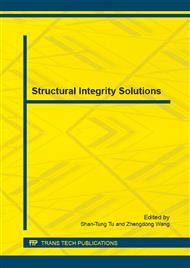[1]
A.A. Doubov. Study of metal properties using magnetic memory method[C]. Copenhagen: (1998).
Google Scholar
[2]
Y. Zhang, S. Yang, X. Xu. Application of metal magnetic memory test in failure analysis and safety evaluation of vessels. Front. Mech. Eng. China. 1 (2009) 40-48.
DOI: 10.1007/s11465-009-0003-3
Google Scholar
[3]
C. Kang, L. Cui, J. Zhang, et al. Experiment research on the metal magnetic memory in gear micro crack detection. Proceedings of the 2011 IEEE International Conference on Mechatronics and Automation, (2011).
DOI: 10.1109/icma.2011.5985825
Google Scholar
[4]
A.A. Dubov, S. Kolokolnikov. Application of the metal magnetic memory method for detection of defects at the initial stage of their development for prevention of failures of power engineering welded steel structures and steam turbine parts. Weld. World. 2 (2014).
DOI: 10.1007/s40194-013-0102-y
Google Scholar
[5]
A.A. Dubov, S. Kolokolnikov. Quality assessment of welded joints by the metal magnetic memory method compared to conventional ndt methods and means for materials properties assessment. 17th World Conference on Nondestructive Testing. Shanghai, China, (2008).
Google Scholar
[6]
P.J. Guo, W.H. Guan, X.D. Chen, et al. Influence of geomagnetic field on the spontaneous magnetic signals. ISSI-2011FM, Anhui, China: (2011).
Google Scholar
[7]
L. Dong, B. Xu, S. Dong, et al. Stress dependence of the spontaneous stray field signals of ferromagnetic steel. NDT & E Inter. 4 (2009) 323-327.
DOI: 10.1016/j.ndteint.2008.12.005
Google Scholar
[8]
L.H. Dong, B.S. Xu, S.Y. Dong, et al. Fundamental research on deformation characterization of ferromagnetic materials by metal magnetic memory testing. Journal of Academy of Armored Force Engineering. 3 (2010) 68-71.
Google Scholar
[9]
D.C. Jiles. Theory of the magnetomechanical effect. Journal of physics D: applied physics. (1995) 1537-1546.
Google Scholar
[10]
J. Li, M. Xu. Influence of uniaxial plastic deformation on surface magnetic field in steel. Meccanica. (2011) 1-5.
Google Scholar
[11]
P.J. Guo, X.D. Chen, W.H. Guan, et al. Effect of tensile stress on the variation of magnetic field of low-alloy steel. J. Magn. Magn. Mater. 323 (2011) 2474-2477.
Google Scholar
[12]
Z.D. Wang, B. Deng, K. Yao. Physical model of plastic deformation on magnetization in ferromagnetic materials. J. Appl. Phys. (2011) 83928(1-6).
Google Scholar
[13]
P.S. Bate, D.V. Wilson. Analysis of the bauschinger effect. Acta Metall. 6 (1986) 1097-1105.
Google Scholar
[14]
E.C. Oliver, M.R. Daymond, P.J. Withers. Interphase and intergranular stress generation in carbon steels. Acta Mater. 7 (2004) 1937-(1951).
DOI: 10.1016/j.actamat.2003.12.035
Google Scholar
[15]
L. Zhi, Y. Lin, C. Lei, et al. X-ray estimation of residual stress carbide in carbon steel t8. Mater. Mech. Eng. 1 (2007) 12-16.
Google Scholar
[16]
A. G. Tanasienko, S. I. Suntsov, A. A. Dubov. Monitoring chemical plant by a metal magnetic memory method. Chem. Petro. Eng. 9 (2002) 624-629.
Google Scholar


